Abstract
The development of advanced tin and niobium bimetallic composite electrode materials is crucial for enhancing the performance of supercapacitors. In this paper, we present a novel bimetallic composite material consisting of zero-dimensional spherical-like SnNb2O6 nanocomposites synthesized through the reaction of tin oxide (SnO2) and niobium pentoxide (Nb2O5) precursors, alongside comparative materials. The morphology of the spherical agglomerates comprising Sn/Nb oxide particles that were nucleated on the SnNb2O6 surface was characterized using field emission scanning electron microscopy (FE-SEM) and high-resolution transmission electron microscopy (HR-TEM). The as-prepared heterostructures of the SnNb2O6 composites were analyzed for elemental composition, including Sn3d, Nb3d, and O1s; moreover, chemical oxidative state analysis was performed through X-ray photoelectron spectroscopy (XPS). Additionally, cyclic voltammetry curves exhibited pseudocapacitive redox behavior for the SnNb2O6 composites, while the galvanostatic charge-discharge (GCD) performance demonstrated a maximum specific capacitance of 294.8 F/g at 1 A/g. Moreover, SnNb2O6 composite electrodes demonstrated rapid charge–discharge kinetics and excellent cycling stability, with a capacitance retention of 95.7% over 10,000 cycles. This study elucidated the synthesis of tin–niobium oxide-based composites, demonstrating their potential for high-performance supercapacitors.
1. Introduction
Energy storage systems play a vital role in the modern world, enabling the efficient use of renewable energy sources, such as wind and solar power, and meeting the increasing demand for portable electronic devices [1]. Among the various energy storage technologies, supercapacitors are significant owing to their high power density, fast charging/discharging capabilities, and long cycle life [2,3,4]. However, enhancing the energy density of supercapacitors remains a considerable challenge. Additionally, compared to batteries, supercapacitors are a promising avenue to increase energy density with the specific capacitance of supercapacitors with advanced electrode materials’ cycling stability [5,6]. However, carbon-based nanomaterials have gained interest for energy storage wide-range applications using supercapacitor electrodes, such as carbon nano tubes (CNTs) and graphene-based nanostructures [7,8].
Among these carbon-based materials, transition bimetallic composites, such as SnO2, Nb2O5, Ti2O, MnO2, NiO, CoO, and Fe2O3, have garnered significant attention in recent years for their potential applications in energy storage and supercapacitors, owing to their unique structural and electrochemical properties [9,10,11,12,13,14]. Among them, composites, typically comprising two transition metals, offer synergistic effects that enhance charge storage pseudo-capacitance mechanisms and electrochemical performance [15]. The tunable composition and morphology of these materials enable properties to be tailored and help optimize energy storage efficiency and stability. Recent research has explored various synthesis methods and characterization techniques to elucidate the structure–property relationships that influence their performance [16]. As demonstrated, transition bimetallic composites hold promise for addressing the growing demand for efficient and sustainable energy storage solutions, making them suitable for use in energy storage, catalysis, electronics, and environmental remediation [16].
Transition bimetallic composites, particularly those containing tin dioxide (SnO2), have garnered significant attention in recent years for their promising applications in energy storage and supercapacitors [17,18]. These composites offer unique synergistic effects arising from the combination of different transition metals with SnO2, leading to enhanced electrochemical properties. One study reported a specific capacitance of 30.46 F/g at 1 mA for a supercapacitor applied using SnO2/activated carbon in an aqueous solution of 1M Na2SO4 [19]. In recent decades, SnO2 (tin (II) oxide) electrodes have attracted significant attention due to their superior chemical stability and optical and electrical properties. Due to these physicochemical characteristics, SnO2 nanostructures have a wide range of applications, such as solar cells, transparent conducting electrodes, gas sensors, optoelectronic devices [20,21,22,23], gas sensing applications, and electrochemical supercapacitors [24,25,26].
Subsequently, materials such as Nb2O5 (niobium (IV) oxide) have been investigated for their potential as electrode materials in supercapacitors [27], owing to their high specific capacitance and stability, as well as in Li–ion batteries [28]. In this context, zero-dimensional (0D) metal chalcogenide spherical composites (SnNb) are favorable for energy storage devices and energy conversion applications [29], which allow for an increase in electrocatalytic activity and provide more active sites for charge storage and faster ion diffusion [30]. These are behaviors of 0D tin–niobate combined with metal oxide-based composites which contribute to the structure and effectively increase the charge transport properties and electrical conductivity of the device [31,32]. Therefore, this material’s large surface area allows for increased electrochemical activity, providing more sites for charge storage and faster ion diffusion. This characteristic contributes to a higher capacitance, enhancing the energy storage capacity of supercapacitors [33]. Additionally, Nb2O5 and SnO2 metal oxide nanoparticles facilitate efficient redox battery-type charge storage, high intrinsic electrical conductivity, and high mechanical strength. However, pristine SnO2 and Nb2O5 metal oxide electrodes may lead to challenges such as poor adhesion and compromised structural integrity over repeated charge/discharge cycles [34]. One of the advantages of both Sn-doped niobium oxide micro-spherical structured materials is easy aggregation, potentially enhancing the chemical stability and surface area and impeding ion accessibility. Fu et al. reported improved capacitive retention and stability using a yolk–shell structure with orthorhombic phase Nb2O5 microspheres via a scalable spray drying method [35]. Additionally, a recent report on SnNb2O6 composite-based materials showed that addressing these merits is crucial to harness the potential of SnNb2O6 and SnO@NbO metal oxide composite electrodes for energy storage [36,37,38] and energy conversion in practical applications [39,40]. Importantly, the addition of Nb2O5 enhances the overall electrochemical performance of pseudo-capacitance and thus improves the charge storage capacity and long-term durability. These binary composites exhibited a synergistic effect between SnO2 and Nb2O5, contributing to improved cycling stability and prolonged electrode life [41,42]. Some reported methods for preparing SnNb2O6 composites include tin–niobate-based binary composites, such as solid-state reaction, molten SnCl2-treated, and solvothermal reaction methods [43,44,45]. Among these, the hydrothermal method has the advantage of binary composite preparation [46].
In the present study, we successfully developed a facile hydrothermal technique involving pyrolysis in an air atmosphere by precisely controlling the spherical particle size and structural morphology of the final product. The as-prepared SnNb2O6 binary composite demonstrated a spherical shape with a uniform size distribution and well-defined shapes. Hydrothermally synthesized SnO2, Nb2O5, and SnNb2O6 composite electrodes were compared using cyclic voltammetry (CV), electrochemical impedance spectroscopy (EIS), and galvanostatic charge–discharge (GCD) analyses. In addition, the as-prepared electrochemical performance of the Nb2O5 and SnO2 electrodes facilitates electrochemical supercapacitor performance. Finally, after successfully fabricating SnNb2O6 composite electrodes, further material analysis was conducted for energy storage applications.
2. Results and Discussion
2.1. X-ray Diffraction Pattern Analysis
The crystal phases of the prepared samples were characterized by X-ray diffraction (XRD). Figure 1 shows XRD patterns of Nb2O5 and their diffracted 2θ, which were 17.38° (044), 22.68° (510), 23.85° (101), 25.58° (530), 28.41° (321), 32.21° (431), 35.32° (611), 38.94° (701), 44.05° (831), 47.59° (002), 51.04° (332), 54.39° (442), 58.37° (642), 64.04° (932), 67.12° (772), 72.27° (822), and 75.08° (303). This indicates a highly crystalline material, and the presence of reflexes corresponding to niobium oxide indicates the oxidation of crystalline H-Nb2O5 [47]. These results show that the diffraction peaks belong to JCPDS card no. (00-016-0053), indicating a monoclinic structure. Then, SnO2 diffraction peaks were observed at 26.61° (110), 33.89° (101), 37.95° (200) 51.78° (211), 54.75° (220), 57.82° (002), 61.87° (310), 64.71° (112), 65.93° (301), 71.27° (202), and 78.71° (321). This indicates that the observed peaks are well-indexed to SnO2 (JCPDS No.00-041-1445), (tetragonal phase), and no predominant peaks were observed for SnO2 in the matrix. No other diffraction peaks were observed. Finally, the main characteristic diffraction peaks were assigned to the main SnNb2O6 composite, with corresponding planes of 22.49° (301), 26.50° (211), 33.94° (202), 38.34° (402), 51.72° (303), 54.54° (802), 57.82° (902), 61.87° (331), 64.92° (111), 66.82° (232), 71.24° (115), and 78.91° (233). In addition, the SnNb2O6 composites showed main characteristic diffracted peaks with reflections at 2θ of 26.50° (211), 33.94° (202), and 78.91° (233). This XRD suggests the corresponding peaks of SnNb2, further confirming the good crystalline nature of the as-prepared composite materials, which were consistent with (JCPDS card No. 00-023-0592) monoclinic crystal structure phase coincident space group P2₁/c [48,49], with Sn@Nb described as “Fordite” metallization of SnNb2O6 with an appropriated combination of Nb, the intermetallic heterostructure H-SnNbO phases, and the oxides NbO and SnO [50]. Additionally, the cycling of XRD data with a discussion on structural stability are provided in the Supplementary Materials (SM) Figures S7–S9. Finally, hydrothermal treatment successfully yielded tin–niobate in the crystalline phase.
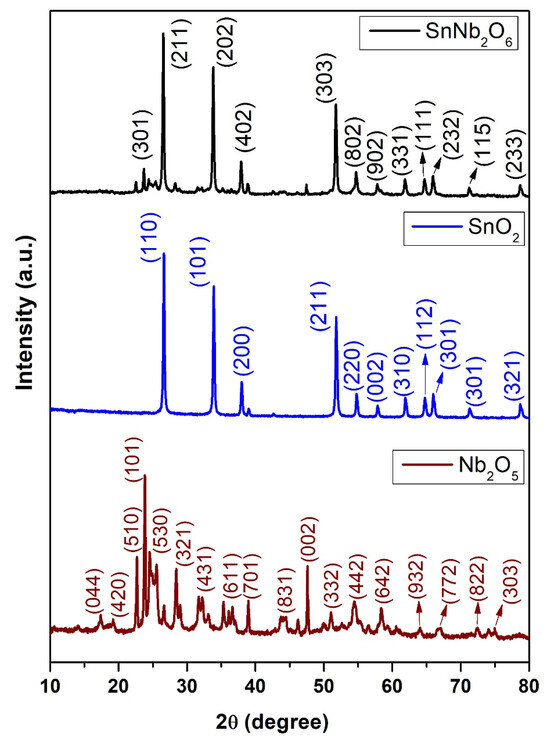
Figure 1.
X-ray diffraction pattern of the as-prepared Nb2O5, SnO2, and SnNb2O6 nanosphere composite.
2.2. Raman Spectroscopy Analysis
Raman spectra were used to analyze the vibrational modes of the molecules and materials. The peaks observed in the Raman spectrum of 0D SnNb2O6 are shown in Figure 2. The peaks at 123.37 cm−1, 268.59 cm−1, 632.26 cm−1, 683.02 cm−1, and 999.46 cm−1 correspond to vibrations in the A1g, Eu, E2g, E12g, B1g, B2g, and Ag modes, which are active in Raman molecular vibrational modes with chemical bonds within the as-prepared sample [51,52]. In addition, the Raman signals in the range of 400 to 800 cm−1 are attributed to symmetric and asymmetric stretching of the Nb-O-Nb bond [53]. Herein, the additional minor peaks at 473.23 cm−1 were associated with E2g1 (in-plane vibration) and B1g/B2g (out-plane vibration) modes at 849.117 cm−1 and 905.01 cm−1 for Sn-O/Nb-O, respectively. Their presence in the binary composite and Raman spectrum of the Nb2O5/SnO2 bimetallic composite indicate the insertion of Sn atoms into the niobium lattice [54,55]. Hence, the mixed oxide in SnO/NbO belongs to the Eg mode, which is a strong indicator of oxygen vacancy appearance during synthesis. The above peaks are correlated to the binary metal oxides combined with the spherical structure of 0D SnNb2O6. In addition, the active Raman intensity peaks reveal that the crystalline structure combines two Nb5+ sites: (i) four oxygen (O2−) atoms bonded with Nb5+ to form corner-sharing NbO4 tetrahedra and (ii) six O2− atoms bonded with Nb5+ to form NbO6 octahedrons [56]. This active site oxide species attached to Nb metal ions and their Raman shift appeared at chemical bond vibrational frequencies of Nb–O–Nb bond bending modes. Raman peaks appearing at 111.17 cm−1, 256.38 cm−1, 620.05 cm−1, 670.81 cm−1, and 987.26 cm−1 correspond to the Nb2O5 phase in-plane vibration E12g and Ag out-plane vibration of the niobium–oxygen bond. The predominant peak was at 256.38 cm−1 (Nb-O stretching vibration); furthermore, the main Raman intensity peaks at 620.05 and 670.81 cm−1 could be attributed to the (A1g) stretching modes of the slightly and highly distorted octahedral NbO6, respectively [57]. In addition, the strong Raman peak around 987.26 cm−1 was due to the terminal double bond Nb = O symmetric stretching mode. The Raman peaks of SnO2 were assigned to Eg and Eu mode vibrations. In particular, the peaks at 227.18 cm−1 and 617.01 cm−1 corresponded to E2g1 and Ag, and these Raman mode vibrations show the spectra of the mixed oxides of optically transparent SnO2 [58]. The band at approximately 617.01 cm−1 was attributed to the Eg mode associated with the symmetrical stretching of the Sn-O bond [59]. In conclusion, the Raman spectra revealed peaks indicating the presence of mixed oxides comprising Sn, O, and Nb atoms.
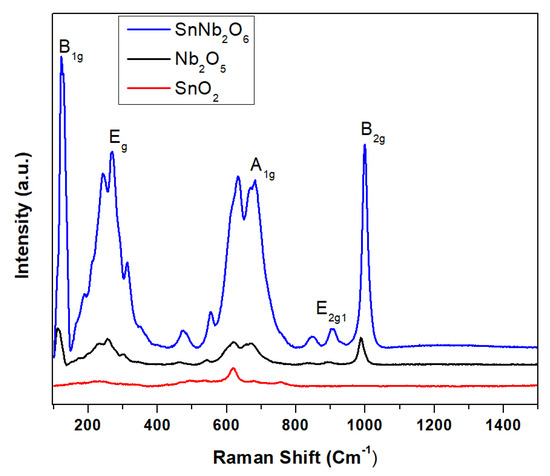
Figure 2.
Raman spectra of the Nb2O5, SnO2, and SnNb2O6 nanosphere composite.
2.3. FE-SEM Image Analysis
Field emission scanning electron microscopy (FE-SEM) and image analysis were used to determine the surface morphologies of the as-prepared heterostructure electrode materials. Figure 3a–f corresponds to the 2D as-prepared Nb2O5, SnO2, and SnNb2O6 heterostructure FE-SEM micrographs. The FE-SEM micrographs of decorated Nb2O5 are shown in Figure 3a, and they exhibit slightly agglomerated nanocrystal surface features, such as edges and surfaces. Figure 3b shows a magnified view of Nb2O5 particles characterized by distinct morphologies and sizes. The FE-SEM images show well-defined structures with a non-uniform particle distribution and accumulation interconnecting each particle. Figure 3c SnO2 shows the formation of agglomerate-spreading micro-structured surface morphology. FE-SEM analysis in Figure 3d reveals SnO2 particles with a remarkably even distribution, with each particle exhibiting a distinct one-by-one growth pattern, which contributes to the formation of a well-defined tin oxide microstructure due to SnO2 particles, indicating a cohesive assembly where individual particles seamlessly join to form cohesive microstructures. Furthermore, the FE-SEM micrographs appear to highlight the favorable conditions for crystalline formation. FE-SEM micrographs are shown in Figure 3a,b for Nb2O5 and Figure 3c,d for SnO2.
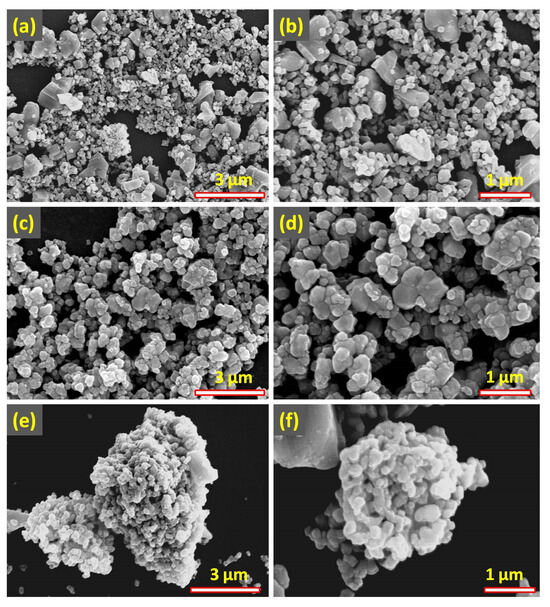
Figure 3.
(a–f) FE-SEM surface morphology images of (a,b) Nb2O5, (c,d) SnO2, and SnNb2O6 nanosphere composites.
Figure 3e,f shows the surface morphology of 0D SnNb2O6, demonstrating better crystalline growth on the 0D structure than on Nb2O5 and SnO2 materials. Moreover, the FE-SEM image in Figure 3e reveals the tailored architecture of the non-uniformed distribution of sphere-like microstructural SnNb2O6 particles with different magnifications. Figure 3e clearly shows the spherical shape with each particle binding with the chemical reaction between niobium oxide (NbO) and stannic oxide (SnO). Under specific conditions, these as-prepared Nb2O5 and SnO2 microparticle precursor materials undergo a solid-state reaction to form the desired tin–niobate compound. During this reaction, the niobium and tin ions rearrange themselves to create a new crystalline structure, SnNb2O6. Initially, smaller particles of the synthesized compound may form, but over time, they coalesce to form larger, more stable spherical particles. From the FE-SEM micrographs, the addition of niobium and tin metals and/or metal oxide exhibits covalent bonding between the spherical structure of tin–niobate. This spherical-like surface morphology provides valuable insights into the incorporation of Nb2O5 and SnO2 microparticle heterostructures to render novel SnNb2O6. Furthermore, it promotes efficient charge transfer kinetics in the electrochemical performance.
2.4. HR-TEM Surface Analysis
The surface morphology of the SnNb2O6 spherical heterostructure was analyzed by HR-TEM. Figure 4a–c shows TEM images of the as-prepared 0D SnNb2O6 nanostructures of the Sn oxide incorporated in Nb2O5 bundles of particles that appeared in a slightly agglomerated structure surface morphology with various in-depth magnifications. Figure 4a shows tin–niobate visible at a surface scale of 100 nm, indicating that the morphology of (SnNb2O6) presents an intricate network of interconnected spherical particles. Each particle exhibits a distinctively smooth surface, suggesting a well-defined interconnection between these particles, which is likely facilitated by the chemical interaction between the component SnO and NbO particles-decorated surface morphologies appearing in the interesting 0D structure. In addition, Figure 4b shows the 50 nm-scale surface morphology. Although the spherical shape remains predominant, the surface texture appears slightly irregular, and the dark part indicates some agglomerated particles, indicating the presence of nanoscale features. Further magnification (Figure 4c) down to a 20 nm scale shows the complex microstructure of (SnNb2O6) with greater clarity. Here, the nonuniformity in the size and arrangement of SnO and NbO particles becomes more distinct, contributing to the heterogeneous nature of the spherical particles. Despite this non-uniformity, each particle retains its spherical shape with smoother edges, highlighting the strength of the interparticle bonding. Finally, the TEM images of the Nb and Sn metallic composites show an enhanced internal surface structure, eventually forming a network of interconnected spherical structures. Owing to the self-organizing nature of the 160 °C hydrothermal synthesis process, the interconnected porous network offers enhanced accessibility for chemical reactions and ion transport, making (SnNb2O6) a promising candidate for advanced heterostructures consisting of functional materials.
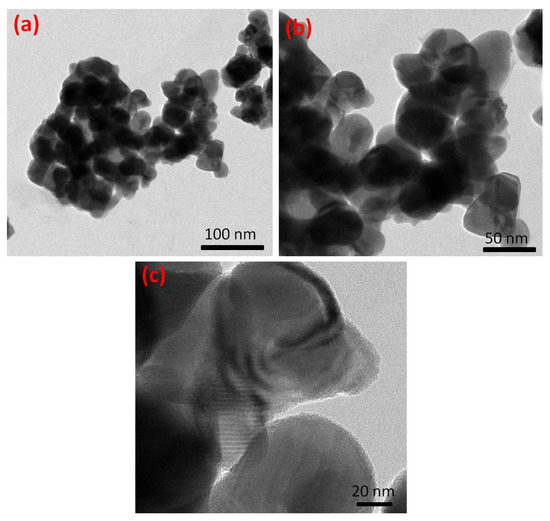
Figure 4.
(a–c) HRTEM surface images of SnNb2O6 sphere nanostructure with different magnifications.
2.5. X-ray Photoelectron Microscopy Analysis
Figure 5 shows the chemical oxidative state of the as-prepared 0D SnNb2O6 spherical composite characterized by XPS analysis. Figure 5a shows that the XPS full survey spectrum of 0D SnNb2O6 belongs to the main core level spectrum of Sn3d, Nb3d, and O1s, with additional sub-core level composition elemental electronic states of Nb4p, Nb3p, Sn3p1, OKLL, and Sn Auger [59]. Additionally, a magnified view of deconvoluted fitting with the background curve of the Shirley background using CASA XPS peak fitting software (http://www.casaxps.com/berlin/) is displayed in Figure 5b for Sn3d, (c) Nb3d, and (d) O1s. Figure 5b shows that the Sn3d core-level XPS spectrum is de-convoluted in the binding energy photoelectron peak position of 486.14 eV and 494.57 eV, corresponding to two peaks due to spin–orbit division, with electrons from the Sn3d5/2 peak and Sn3d3/2 states of Sn(4+). Figure 5c shows that niobium typically exhibits two peaks that are often deconvoluted into Nb 3d at around 212.4 eV and 211.3 eV, corresponding to the Nb3d5/2 and Nb3d3/2 shown in Figure 5c. These results suggest the presence of niobium oxide in the bulk region; the oxidation state of niobium results from a mixture of Nb5+ and Nb2+ oxidation states, i.e., Nb2O5 [60]. Finally, the O1s deconvoluted spectrum demonstrates binding energy values of 529.76 eV and 530.74 eV, assigned to O-Nb-O and Sn-O, respectively, and exhibit the existence of oxygen in different environments in oxygen groups present in the SnNb2O6 composite. Herein, these O1s reveal the natural oxidative spectrum, showing that the binding energy value presence of the Nb2O5 phase in this sample is predominantly due to the oxidation of the surface after exposure to air. The XPS overall survey spectra are major core-level spectra with a surface composition in atomic percentages (at.%) of Sn3d (8.55), Nb3d (18.20), and O1s (73.25) present in the 0D SnNb2O6 composite.
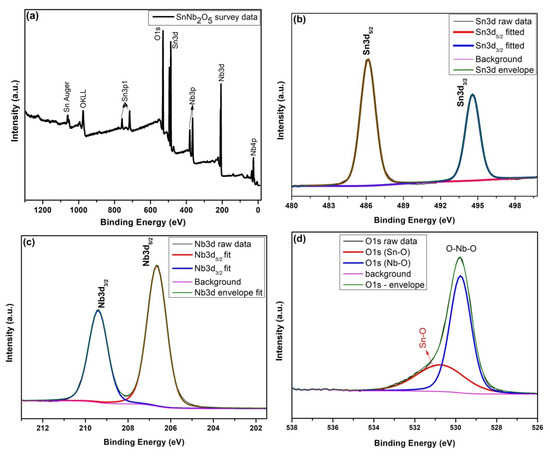
Figure 5.
(a–d) XPS survey spectra of Nb 3d, Sn 3d, and O 1s of the as-prepared SnNb2O6 composite. (b) Deconvoluted fitting for Sn3d, (b) deconvoluted fitting for Nb3d, and (b) deconvoluted fitting for O1s.
2.6. Electrochemical Analysis
The electrochemical performance was evaluated through CV, EIS, and GCD techniques for the SnNb2O6, Nb2O5, and SnO2 electrodes, respectively. Three-electrode electrochemical testing was conducted within an optimum potential range spanning from −0.2 V to +0.55 V, utilizing a 3M aqueous KOH electrolyte. The 0D SnNb2O6 heterostructure composite electrode is shown in Figure 6a. CV provides valuable insights into the electrochemical behavior at various scan rates ranging from 10 to 100 mV/s. In the CV curves, increasing the sweep rate exhibits enhanced redox peaks within the potential range from −0.2 V to +0.55 V, resulting in the widening of the electrochemical active current range, indicative of enhanced kinetics. Moreover, the concurrent elevation of the oxidation and reduction current peaks signifies a robust electrochemical redox response within the test window. This is indicative of its superior charge storage capacity. Thus, CV can help elucidate their redox processes and pseudo-capacitive nature.

Figure 6.
(a) Cyclic voltammetry (CV) and (c) galvanostatic charge–discharge (GCD) at (−0.2–0.55 V) versus Ag/AgCl with 3M KOH and (b) electrochemical impedance spectroscopy (EIS) for SnNb2O6 electrode.
EIS is used to characterize the electrochemical electrode–electrolyte interface resistance behavior of materials, especially in the context of the SnNb2O6 composite. Furthermore, the electrochemical performance of the EIS–Nyquist plot revealed a pronounced response in the high-frequency range, consisting of solution resistance (Rs, 1.09 Ω) and efficient charge transfer resistance (Rct, 2.25 Ω), showing a condensed electrode–electrolyte interface. The Rct value suggests that electrolyte ions move through efficient ion diffusion within the electrode (SnNb2O6) and an intermediate-frequency region related to the Warburg impedance (WΩ) linear line for good capacitive behavior. These EIS results suggest favorable electrochemical behavior, potentially facilitating enhanced reaction kinetics and overall performance of the electrode material.
In addition, as shown in Figure 6c, the electrochemical performance of the GCD profiles was evaluated for SnNb2O6 favorable charge/discharge characteristics and its potential range (−0.2 V to +0.55 V) as a high-performance electrode material in a 3M aqueous KOH electrolyte. The GCD curves reveal the calculated (Equation (1)) specific capacitance (Csp) of 294.02 F/g, 143.29 F/g, 80.20 F/g, 54.77 F/g, and 39.50 F/g, which correspond to applied varying current densities of 1 A/g, 2 A/g, 3 A/g, 4 A/g, and 5 A/g, respectively. Additionally, in the GCD profile, notable pseudo-capacitive behaviors were observed, indicating enhanced energy storage properties. The incorporation of Sn with the Nb bimetallic oxide spherical composite resulted in a significant increase in the storage capacity; therefore, the SnNb2O6 electrode is a key contributor to the advancement of electrochemical energy storage technologies.
Additionally, Nb2O5 electrodes of CV, EIS, and GCD curves were recorded, as shown in Figure 7a–c. As shown in Figure 7a, the CV curves reveal that the redox reactions are associated with pseudo-capacitance and their charge storage capabilities, which has gained attention owing to their unique energy storage properties. The CV curves provide information on the charge transfer processes at the redox interface between the K+ and OH− ions. The electrochemical CV performance of Nb2O5 exhibited notable redox current peaks, indicating a favorable response within the active window. Increasing scan rates corresponded to increased current rates, expanding the area under the CV curve, which is indicative of enhanced electrochemical activity.
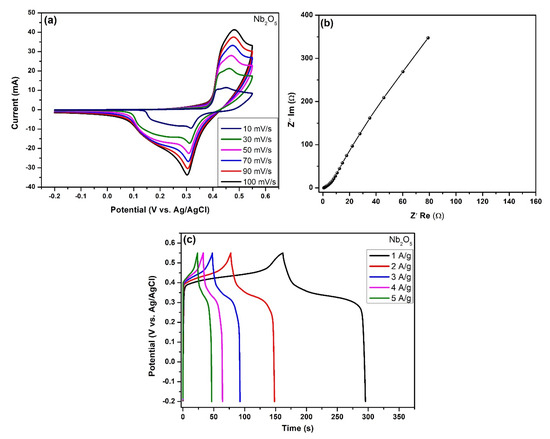
Figure 7.
(a) Cyclic voltammetry (CV) and (c) galvanostatic charge–discharge (GCD) curves and (b) electrochemical impedance spectroscopy (EIS) for Nb2O5 electrode.
We investigated the EIS properties of Nb2O5 electrode materials with excellent electrochemical impedance activity and potential for energy storage applications. The EIS high-frequency region x-axis involves measuring the impedance response using the Nyquist plots of an electrode, which provides valuable information about solution resistance (Rs, 0.72 Ω) and charge transfer resistance (Rct, 3.35 Ω). Both Rs and Rct values exhibited distinct behaviors, indicating improved conductivity and reduced charge transfer resistance. Therefore, impedance analyses of Nb2O5 electrode materials in the high-frequency region revealed notable enhancements in charge transfer kinetics at the electrode–electrolyte interface.
In addition, GCD for Nb2O5 electrodes can be used to enhance the capacity of the electrode. GCD curves of the Nb2O5 electrode demonstrated Csp values of 132 F/g, 83.60 F/g, 59.06 F/g, 42.48 F/g, and 27.61 F/g matching under various constant applied current densities of 1 A/g, 2 A/g, 3 A/g, 4 A/g, and 5 A/g, respectively, as derived from Equation (1). These GCD curves showed significant enhancement, leading to prolonged discharge times. Furthermore, niobium oxide offers high conductivity and capacity, ensures efficient metal–ion diffusion, and stabilizes the electrode structure. These findings highlight the potential of Nb2O5 as a high-performance electrode material for energy storage applications.
CV curves of the SnO2 electrode offer insights into the synergistic effects of these materials, such as enhanced charge storage capacity or catalytic activity. The electrochemical performance of SnO2 was evaluated through CV. The observed oxidation and reduction current peaks indicate its favorable redox activity. Increasing the scan rate led to a simultaneous rise in the current rate and a broadening of the CV curve area. These findings suggest an expanded electrochemically active window for SnO2 within the fixed potential window range (−0.2 to +0.55). The CV analyses contribute to the understanding of the electrochemical redox properties of the SnO2 electrode for supercapacitors.
Moreover, as shown in Figure 8b, the SnO2 electrode demonstrates EIS analyses and offers valuable insights into the electrochemical behavior. The Nyquist plot of the SnO2 electrodes revealed distinct features in the high-frequency range, indicating complex electrochemical behavior. In addition, the Nyquist plot solution resistance (Rs, 0.68 Ω) and charge transfer resistance (Rct, 7.64) were effectively determined from the high-frequency region. The low-frequency region comprises Warburg impedance (WΩ) at a 45° slope. This EIS results in a significant understanding of the impedance characteristics of the kinetics at the electrode–electrolyte interface. Notably, the observed Rct values were slightly higher than those of the SnNb2O6 and Nb2O5 electrodes for optimizing the electrode performance in terms of the efficiency of charge transfer processes. Figure 8c shows GCD curves for enhancing the electrochemical performance of SnO2 electrode materials with different current densities. The GCD curves determined the Csp values of 132 F/g, 83.60 F/g, 59.06 F/g, 42.48 F/g, and 27.61 F/g for various applied current densities of 1 A/g, 2 A/g, 3 A/g, 4 A/g, and 5 A/g, respectively. This exhibited the promising electrochemical performance of these materials for energy storage applications. Figure 8c shows the GCD curves of the SnO2 electrode and the synergistic effects arising from tin oxide, which can potentially lead to enhanced electrochemical properties.
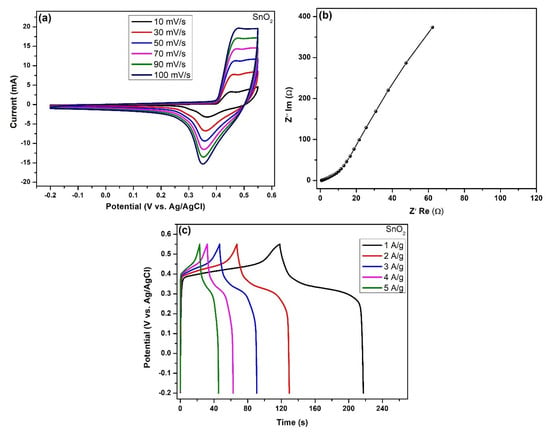
Figure 8.
(a) Cyclic voltammetry (CV) and (c) galvanostatic charge–discharge (GCD) curves and (b) electrochemical impedance spectroscopy (EIS) for SnO2 electrode.
Finally, the overall CV, EIS, and GCD results indicate promising characteristics for potential electrochemical applications. The separate results and discussion include the analysis necessary for the CV, EIS, and GCD performance in Figure 6a–c, Figure 7a–c, and Figure 8a–c, respectively. Interestingly, all the data combined with the CV curves depicted in Figure 9a illustrate the electrochemical activity of the three electrode active materials: SnO2, Nb2O5, and SnNb2O6 spherical composites. Notably, the SnNb2O6 composite exhibited enhanced electrochemical activity compared with the SnO2 and Nb2O5 electrodes. This enhancement was evident from the higher current response observed in the CV curves. Figure 9b depicts the EIS analysis of the comparative samples, analyzed using z-fit (EC-Lab) software combined with BIOLOGIC. The Nyquist impedance plots illustrate the relationship between ZreΩ (Z′) and ZimΩ (Z″) across a frequency range from 100 kHz to 100 mHz. In Figure 9 (inset, electrical Randle’s circuit: ((R1 + Q1/W + R2) + Q2)), the higher-frequency region displays R1, representing the solution resistance (Rs)R1, and the charge transfer resistance (Rct) R2 represents the electrode–electrolyte interface. In addition, the lower-frequency region encompasses the diffusion impedance of the Warburg element (WΩ) and mass-transfer (Q1, Q2) constant phase element of pseudo-capacitance, represented at the intersection point of Randle’s z-fitted circuit the comparative values assessment displayed in Table S1. Analysis of the EIS–Nyquist plot along the ZreΩ axis reveals charge transfer resistance values of 2.25 Ω, 3.35 Ω, and 7.64 Ω for SnO2, Nb2O5, and SnNb2O6 spherical composites, respectively. The Rct value is lower for the SnNb2O6 spherical composite compared to the SnO2 and Nb2O5 electrodes. These EIS results indicate superior kinetics at the electrode–electrolyte interface, favoring efficient charge transfer processes. Additionally, the low-frequency region linear plots that fit in the EIS–Nyquist impedance spectra with calculated diffusion coefficients for each electrode material data with information (Supplementary Materials SM; Figures S1a,b, S2a,b and S3a,b) were used to calculate the diffusion coefficient of K+ ions. In addition, Figure 9c compares the charge–discharge profiles of the three-electrode system. In addition, the exhibited overall maximum specific capacitances of 132.84 F/g, 177.94 F/g, and 294.02 F/g correspond to the SnO2, Nb2O5, and SnNb2O6 composites displayed at constant current density 1 A/g, respectively. Thus, the overall compared CV, EIS, and GCD results of the SnNb2O6 composite to enhance the electrochemical supercapacitor analyses provide insights into their electrochemical behavior. The advantages of SnNb2O6 composites are highlighted by comparing them to previous literature reports in Table S2.
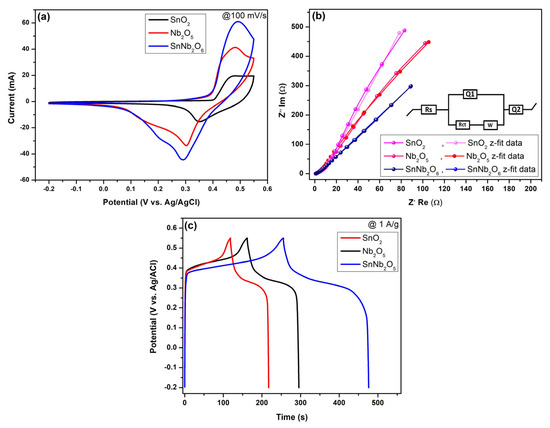
Figure 9.
Overall comparative profile: (a) CV data with 100 mV/s, (b) EIS–Nyquist plot showing the experimental and inset Randel’s electrical circuit for z-fitted data at 100 Hz–100 mHz, and (c) GCD curves with 1 A/g.
2.7. Electrochemical Cycling Stability
Electrode stability analyses are crucial for assessing the long-term performance of materials in various electrochemical applications. Electrode stability analyses reveal that these electrodes are suitable for maintaining supercapacitor behavior over extended periods of continuous charge–discharge cycles. Herein, we focus on the stability of electrodes based on the SnO2, Nb2O5, and SnNb2O6 composites with an applied current density of 5 A/g. Figure 10 shows the stability curves of SnNb2O6 composites (green line), known for their excellent superconducting properties with capacity retention (CR, 96.15%) over 5000 cycles. This synergy leads to improved charge–discharge rates and prolonged cycle life. However, exposure to moisture and chemical contaminants can degrade their performance, emphasizing the importance of Sn–Nb bimetallic 0D spherical composite active materials. Comparing the best overall electrochemical performance, the heterostructure (SnNb2O6) composite electrode system combines tin (Sn) and niobium (Nb), both of which exhibit interesting electrochemical properties. This combination results in superior charge–discharge performance and extended cycle life.
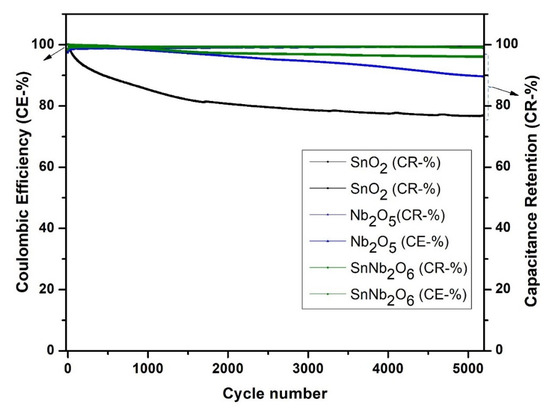
Figure 10.
Coulombic efficiency (CE %) (η) versus capacitance retention (CR %) for overall electrode cyclic stability performance at 5 A/g for 5000 cycles.
The cycling stability performance visualized with GCD curves demonstrated the comparable electrodes and capacity retention of SnO2 (CR, 76.73%) and Nb2O5 (89.86%), respectively. Each material offers unique advantages, and the choice depends on specific requirements such as capacity, rate capability, and cycle life of the targeted energy storage device. However, the electrode’s long-term performance columbic efficiency (CE%) for the three comparative electrodes is enhanced to 99.5%, and this charge–discharge efficiency has proven that these are stable active materials with only gradual decreases over 5000 cycles. Tin combined with the niobium oxide-based spherical composite electrode SnNb2O6 exhibited notable stability, maintaining its superior electrochemical properties. However, without distinct pure SnO2 and Nb2O5 electrodes, a lower capacity and cycling capacity retention may occur. Figure 10 shows the stability curve of the SnNb2O6 composite electrode. This makes it a promising candidate for superconducting electronics and energy storage applications.
3. Experimental Section
3.1. Materials and Methods
Potassium stannate (K2O3Sn), 99.9%, Macklin) trace-metals basis, (Sigma-Aldrich chemicals), St. Louis, MO, USA, niobium (II) oxide (Nb2O2), (99.9% trace metals basis, Sigma-Aldrich), absolute ethanol (Sigma-Aldrich), and cetyltrimethylammonium bromide (CTAB) (99.0%, Sigma-Aldrich) were purchased, and all chemicals were of analytic grade and used without further purification.
3.2. Preparation of 0D SnNb2O6 Heterostructure Sphere
Micrometer-sized SnNb2O6 spheres were synthesized via a facile hydrothermal preparation of potassium stannate (K2O3Sn) and niobium (II) oxide (Nb2O2) powders at a gravimetric proportion ratio of 1:1. Specifically, in typical synthesis, both precursors used as dry powders were mixed vigorously, ground in an agate mortar for 5 min, and mixed in 30 mL absolute ethanol vigorous magnetic stirrer for 30 min while slowly adding 20 mL of CTAB solution. The solution was homogeneous as analyzed by a high-frequency probe under high-amplitude ultrasonic waves using a probe sonication instrument (500 W, 20 kHz) and three 3 s ultrasound pulses, with a spacing of 1 s between each. The homogeneous mixture solution was then transferred to a hydrothermal reaction vessel in a Teflon-lined autoclave covered with stainless steel and the reaction was held at this temperature of 160 °C for 12 h. Then, the reaction vessel was allowed to naturally cool to room temperature. The cooled reactor and precipitate were collected by centrifugation and washed with deionized (DI) water and absolute ethanol to remove any unreacted precursors or byproducts. Finally, the precipitated material was vacuum-filtered through a micropore glass fiber membrane and washed with deionized water. Finally, the solid material (SnNb2O6) obtained was sintered at 500 °C for 2 h to remove residual moisture. Subsequently, SnO2 and Nb2O5 comparative sample materials were synthesized using the same experimental procedure. The as-synthesized SnNb2O6 was characterized by various analytical techniques for further material conformation analysis.
3.3. Materials Characterization
The as-prepared SnO2, Nb2O5, and SnNb2O6 composite materials were further characterized. The phase composition of the samples was determined using X-ray powder diffraction of crystal structures, and their planes were observed using “X’Pert PRO PAN-Analytical” operating at 40 kV and 30 mA with Cu-Kα as an X-ray source (λ = 1.5406 Å), from 10° to 80°, accelerating voltage of 30 kV, and a beam current of 30 mA. Laser Raman spectroscopy scattering spectra were recorded using an XPLORA Plus (HORIBA Scientific, Horiba Jobin Yvon, Palaiseau, France) at room temperature, excited with a YAG (Nd) laser at 532 nm, with a spectrum gain time of 100 s and operating power of 10 mW. Surface morphologies were investigated using FE-SEM images obtained via S-4800 coupled with energy dispersive spectroscopy (EDS) (Tokyo, Japan) at an accelerating voltage of 15 kV. In addition, FE-TEM was used for different magnifications of nanoscale surface recorded with an ‘FEI-TECNAI’ TF-20 through an operating accelerating voltage of 200 kV. Oxidation states of each element present in the SnNb2O6 spherical composites using XPS (Thermo Scientific K-Alpha system with an Al Kα X-ray source) were used to analyze the ion source energy between 100 V and 3 keV. Finally, the surface area of each sample was determined using 3Flex of the SnO2, Nb2O5, and SnNb2O6 materials with a BET analyzer (Gemini™ V Series 2380, Micromeritics, Norcross, GA, USA). The BET data and discussion are provided in the Supplementary Materials (SM) Section (Figures S4–S6)).
3.4. Active Material Preparation and Electrochemical Characterization
A supercapacitor with active materials of SnO2, Nb2O5, and SnNb2O6 composites was applied for an electrochemical energy storage three-electrode system. The preparation of the working electrode involved weight percentages of 80%:10%:10% corresponding to SnO2, Nb2O5, and SnNb2O6, which acted as an active material, conductive polymeric binder as polyvinylidene fluoride (PVDF), and conductive additive as an activated carbon black (AC), respectively. Mixtures of the above three sources (Active materials; AC; PVDF) were ground by a mortar and pestle for 10 min, and subsequently, N-methyl-2-pyrrolidone (NMP) solvent solution was added to a uniform slurry paste to form an ink-like mix. Then, the supercapacitor conductive electrode was used with cleaned nickel (Ni)-foam substrate (2.5 × 1 cm−2). Subsequently, the active material catalyst coating of slurry ink was coated on Ni-foam subtracts (1 × 1 cm−2) with a manual brush. Furthermore, all slurry-coated electrodes were dried at 80 °C overnight to remove excess solvent. The electrochemical three-electrode cell setup contained platinum (Pt) foil as the counter electrode, silver/silver chloride (Ag/AgCl) as the reference electrode, and Ni–foam slurry coating as the working electrode. The 3M potassium hydroxide (KOH) was used as an aqueous electrolyte medium. After electrochemical measurement using a BIO-LOGIC electrochemical workstation, further electrochemical demonstration by CV, EIS, and GCD was carried out in the three-electrode potential range (−0.2 to +0.55) using 3M KOH aqueous electrolytes. The specific capacitance was calculated from GCD measurements, which can be calculated from the GCD curves as follows:
where Csp, I, Δt, ΔV, and m correspond to specific capacitance (F/g), constant discharge current (A), discharge time (s), total potential window (V), and mass of the active material (mg), respectively.
Csp = (I × Δt)/(m × ΔV) F/g,
4. Conclusions
Z0D SnNb2O6 composites were successfully synthesized using a straightforward hydrothermal method followed by pyrolysis. The as-prepared composite exhibited a monoclinic crystal structure, as confirmed by XRD. The surface morphologies of the synthesized binary composites were examined using FE-SEM and HR-TEM. The chemical oxidative states of Sn3d, Nb3d, and O1s, along with their respective binding energies (486.12, 206.66, and 529.8 eV) were determined by XPS surface survey analysis. Raman spectroscopy identified associated in-plane vibrations at 473.23 cm−1 (E2g1) and out-of-plane vibration modes at B1g/B2g 849.117 cm−1 and 905.01 cm−1, corresponding to Sn-O/Nb-O bonds. The as-prepared active materials were evaluated for electrochemical supercapacitor applications using CV, EIS, and GCD analyses. In GCD analyses, the Csp of the SnNb2O6 spherical composite was found to be 294.02 F/g, and comparative electrode performance was observed in both SnO2 (Csp-132.84 F/g) and Nb2O5 (Csp-177.94 F/g) under similar test conditions at a current density of 1 A/g. Furthermore, these findings underscore SnNb2O6 as a promising electrode material. Meanwhile, the capacity retention of the as-prepared SnNb2O6 binary composite electrode remained stable over 5000 cycles at a higher current density of 5 A/g. The tin/niobium composite presents a promising platform for efficient energy storage and advanced supercapacitor energy storage devices.
Supplementary Materials
The following supporting information can be downloaded at: https://www.mdpi.com/article/10.3390/inorganics12060142/s1, Figure S1: Nyquist impedance plot for SnO2 and the, the Warburg impedance with the diffusion coefficient using Nyquist plot a linear line fitting SnO2 data; Figure S2: Nyquist impedance plot for Nb2O5 and the, the Warburg impedance with the diffusion coefficient using Nyquist plot a linear line fitting Nb2O5 data; Figure S3: Nyquist impedance plot for SnNb2O6 and the, the Warburg impedance with the diffusion coefficient using Nyquist plot a linear line fitting SnNb2O6 data; Figure S4: BET isotherm graph of specific surface area analysis of SnNb2O6 composite material with quantitative volumetric adsorbed (Cm3/g) versus relative pressure isotherm in terms of P/P0; Figure S5: BET surface area analysis with N2 adsorption/desorption isotherms linear curves of Nb2O5 material; Figure S6: BET surface area analysis with N2 adsorption/desorption isotherms linear curves of SnO2 material; Figure S7: X-ray diffraction (XRD) patterns of SnO2 electrode for after cycling data.; Figure S8: X-ray diffraction (XRD) patterns of Nb2O5 electrode for after cycling data; Figure S9: X-ray diffraction (XRD) patterns of SnNb2O6 electrode for after cycling data; Table S1: Electrochemical impedance spectroscopy (EIS) is a Nyquist plot with measured by z-fit software fitting to an equivalent electrical circuit model; Table S2: Comparison of previous reported supercapacitor composite electrode materials for energy storage applications. Supplementary Materials References [61,62,63,64,65,66,67,68,69,70,71,72,73].
Author Contributions
Conceptualization, methodology, validation, writing—original draft preparation, V.T.; formal analysis, resources, data curation, writing—original draft preparation, P.R.; writing—review and editing, supervision, J.-H.K.; supervision, project administration, funding acquisition, B.B.; writing—review and editing, supervision, K.Y. All authors have read and agreed to the published version of the manuscript.
Funding
This work was supported by the National Research Foundation of Korea (NRF) grant funded by the Korea Government (MSIT) (No. 2022R1A2C1005357).
Data Availability Statement
The data supporting the findings of this study are available from the corresponding author upon reasonable request.
Conflicts of Interest
The authors declare that they have no conflicts of interest regarding the publication of this article, financial or otherwise.
References
- Aricò, A.S.; Bruce, P.; Scrosati, B.; Tarascon, J.-M.; van Schalkwijk, W. Nanostructured materials for advanced energy conversion and storage devices. Nat. Mater. 2005, 4, 366–377. [Google Scholar] [CrossRef] [PubMed]
- Conway, B.E. Electrochemical Supercapacitors: Scientific Fundamentals and Technological Applications; Kluwer-Plenum: New York, NY, USA, 1999. [Google Scholar]
- Burke, A. Ultracapacitors: Why, how, and where is the technology. J. Power Sources 2000, 91, 37–50. [Google Scholar] [CrossRef]
- Kotz, R.; Carlen, M. Principles and applications of electrochemical capacitors. Electrochim. Acta 2000, 45, 2483–2498. [Google Scholar] [CrossRef]
- Chu, A.; Braatz, P. Comparison of commercial supercapacitors and highpower lithium-ion batteries for power-assist applications in hybrid electric vehicles I. Initial characterization. J. Power Sources 2002, 112, 236–246. [Google Scholar] [CrossRef]
- Goikolea, E.; Mysyk, R. Nanotechnology in Electrochemical Capacitors. In Emerging Nanotechnologies in Rechargable Energy Storage Systems; Elsevier: Amsterdam, The Netherlands, 2017; pp. 131–169. [Google Scholar] [CrossRef]
- Yang, W.; Ni, M.; Ren, X.; Tian, Y.; Li, N.; Su, Y.; Zhang, X. Graphene in Supercapacitor Applications. Curr. Opin. Colloid Interface Sci. 2015, 20, 416–428. [Google Scholar] [CrossRef]
- Pan, H.; Li, J.; Feng, Y.P. Carbon Nanotubes for Supercapacitor. Nanoscale Res. Lett. 2010, 5, 654–668. [Google Scholar] [CrossRef] [PubMed]
- Chmiola, J.; Largeot, C.; Taberna, P.-L.; Simon, P.; Gogotsi, Y. Monolithic carbide-derived carbon films for micro-supercapacitors. Science 2010, 328, 480–483. [Google Scholar] [CrossRef] [PubMed]
- Xu, J.; Wang, Y.; Chen, W.; Ge, J.; An, L.; Sun, L. Titanium suboxide (Ti2O) as a new anode material for lithium-ion batteries. Electrochem. Commun. 2013, 30, 73–76. [Google Scholar]
- Lee, S.W.; Gallant, B.M.; Byon, H.R.; Hammond, P.T.; Shao-Horn, Y. Nanostructured carbon-based electrodes: Bridging the gap between thin-film lithium-ion batteries and electrochemical capacitors. Energy Environ. Sci. 2011, 4, 1972–1985. [Google Scholar] [CrossRef]
- Ma, W.; Zhou, W.; Yang, F.; Liu, Z.; Cui, G.; Yin, W.; Zhao, D. FeO nanoparticles embedded in nitrogen-doped porous carbon nanosheets as high-performance anode materials for lithium-ion batteries. J. Mater. Chem. A 2018, 6, 7077–7085. [Google Scholar]
- Guo, Y.; Zhu, Z.; Chen, Y.; He, H.; Li, X.; Qin, T.; Wang, Y. High-Performance Supercapacitors of Ruthenium-Based Nanohybrid Compounds. J. Alloys Compd. 2020, 842, 155798. [Google Scholar] [CrossRef]
- Nguyen, T.; Boudard, M.; Carmezim, M.J.; Montemor, M.F. Layered Ni(OH)2-Co(OH)2 films prepared by electrodeposition as charge storage electrodes for hybrid supercapacitors. Sci. Rep. 2017, 7, 39980. [Google Scholar] [CrossRef]
- Augustyn, V.; Simon, P.; Dunn, B. Pseudocapacitive Oxide Materials for High-Rate Electrochemical Energy Storage. Energy Environ. Sci. 2014, 7, 1597–1614. [Google Scholar] [CrossRef]
- Zhang, Z.; Huang, Y.; Li, S.; Wang, X.; Wei, F. Recent advances in transition metal-based bimetallic oxide composites for electrochemical energy storage. Energy Storage Mater. 2020, 27, 28–52. [Google Scholar] [CrossRef]
- Balaji, T.E.; Tanaya Das, H.; Maiyalagan, T. Recent Trends in Bimetallic Oxides and Their Composites as Electrode Materials for Supercapacitor Applications. ChemElectroChem 2021, 8, 1723–1746. [Google Scholar] [CrossRef]
- Wang, G.; Zhang, L.; Zhang, J. A review of electrode materials for electrochemical supercapacitors. Chem. Soc. Rev. 2012, 41, 797–828. [Google Scholar] [CrossRef]
- Elyazed, A.S.A.; Hassan, S.; Ashry, A.G.; Hegazy, M. Facile, Efficient, and Cheap Electrode based on SnO2/Activated Carbon Waste for Supercapacitor and Capacitive Deionization Applications. ACS Omega 2022, 7, 19714–19720. [Google Scholar] [CrossRef]
- Wang, X.; Fan, H.; Ren, P. UV light-assisted synthesis of coral SnO2: Characterization and its enhanced photocatalytic properties. Colloids Surf. A Physicochem. Eng. Asp. 2012, 402, 53–59. [Google Scholar] [CrossRef]
- Gao, Y.; Wu, J.; Zhang, W.; Tan, Y.; Tang, T.; Wang, S.; Tang, B.; Zhao, J. SO42-/SnO2 as a new electrode for electrochemical supercapacitors. Ceram. Int. 2014, 40, 8925–8929. [Google Scholar] [CrossRef]
- Gebreslassie, Y.T.; Gebretnsae, H.G. Green and cost-effective synthesis of tin oxide nanoparticles: A review on the synthesis methodologies, mechanism of formation, and their potential applications. Nanoscale Res. Lett. 2021, 16, 97. [Google Scholar] [CrossRef]
- Mishra, S.R.; Ahmaruzzaman, M. Tin oxide based nanostructured materials synthesis and potential applications. Nanoscale 2022, 14, 1566–1605. [Google Scholar] [CrossRef] [PubMed]
- Bonu, V.; Gupta, B.; Chandra, S.; Das, A.; Dhara, S.; Tyagi, A. Electrochemical supercapacitor performance of SnO2 quantum dots. Electrochim. Acta 2016, 203, 230–237. [Google Scholar] [CrossRef]
- Velmurugan, V.; Srinivasarao, U.; Ramachandran, R.; Saranya, M.; Grace, A.N. Synthesis of tin oxide/graphene (SnO2/G) nanocomposite and its electrochemical properties for supercapacitor applications. Mater. Res. Bull. 2016, 84, 145–151. [Google Scholar] [CrossRef]
- Wang, Y.-X.; Lim, Y.-G.; Park, M.-S.; Chou, S.-L.; Kim, J.H.; Liu, H.-K.; Dou, S.-X.; Kim, Y.-J. Ultrafine SnO2 nanoparticle loading onto reduced graphene oxide as anodes for sodium-ion batteries with superior rate and cycling performances. J. Mater. Chem. A 2014, 2, 529–534. [Google Scholar] [CrossRef]
- Pang, R.; Wang, Z.; Li, J.; Chen, K. Polymorphs of Nb2O5 Compound and Their Electrical Energy Storage Applications. Materials 2023, 16, 6956. [Google Scholar] [CrossRef] [PubMed]
- Han, X.; Meng, Q.; Wan, X.; Sun, B.; Zhang, Y.; Shen, B.; Gao, J.; Ma, Y.; Zuo, P.; Lou, S.; et al. Intercalation pseudocapacitive electrochemistry of Nb-based oxides for fast charging of lithium-ion batteries. Nano Energy 2021, 81, 105635. [Google Scholar] [CrossRef]
- Liu, S.; Zhou, J.; Cai, Z.; Fang, G.; Pan, A.; Liang, S. Nb2O5 microstructures: A high-performance anode for lithium ion batteries. Nanotechnology 2016, 27, 46LT01. [Google Scholar] [CrossRef] [PubMed]
- Liu, X.; Liu, G.; Liu, Y.; Sun, R.; Ma, J.; Guo, J.; Hu, M. Urchin-like hierarchical H-Nb2O5 microspheres: Synthesis, formation mechanism and their applications in lithium ion batteries. Dalton Trans. 2017, 46, 10935–10940. [Google Scholar] [CrossRef] [PubMed]
- Katayama, S.; Hayashi, H.; Kumagai, Y.; Oba, F.; Tanaka, I. Electronic structure and defect chemistry of tin (II) complex oxide SnNb2O6. J. Phys. Chem. C 2016, 120, 9604–9611. [Google Scholar] [CrossRef]
- Zhai, P.; Qin, J.; Guo, L.; Zhao, N.; Shi, C.; Liu, E.Z.; He, F.; Ma, L.; Li, J.; He, C. Smart hybridization of Sn2Nb2O7/SnO2@3D carbon nanocomposites with enhanced sodium storage performance through self-buffering effects. J. Mater. Chem. A 2017, 5, 13052–13061. [Google Scholar] [CrossRef]
- Kong, X.; Zhang, J.; Huang, J.; Li, J.; Qin, Y.; Zhao, T.; Feng, Q. Microwave assisted hydrothermal synthesis of tin niobates nanosheets with high cycle stability as lithium-ion battery anodes. Chin. Chem. Lett. 2019, 30, 771–774. [Google Scholar] [CrossRef]
- Lu, H.; Xiang, K.; Bai, N.; Zhou, W.; Wang, S.; Chen, H. Urchin-shaped Nb2O5 microspheres synthesized by the facile hydrothermal method and their lithium storage performance. Mater. Lett. 2016, 167, 106–108. [Google Scholar] [CrossRef]
- Fu, S.; Yu, Q.; Liu, Z.; Hu, P.; Chen, Q.; Feng, S.; Mai, L.; Zhou, L. Yolk-Shell Nb2O5 Microspheres as Intercalation Pseudocapacitive Anode Materials for High-Energy Li-ion Capacitors. J. Mater. Chem. A 2019, 7, 11234–11240. [Google Scholar] [CrossRef]
- Liu, Q.; Du, Z.; Wang, X.; Wang, R.; Cheng, M.; Hu, J.; Wei, T.; Ling, Y.; Cui, Y.; Wei, Y.; et al. Sandwich-like N-doped carbon coated SnNb2O6 nanosheets for high-rate and long-life lithium storage. J. Alloy. Compd. 2024, 970, 172095. [Google Scholar] [CrossRef]
- Huang, M.; Liu, J.X.; Huang, P.; Hu, H.; Lai, C. Self-assembly synthesis of SnNb2O6/amino-functionalized graphene nanocomposite as high-rate anode materials for sodium-ion batteries. Rare Met. 2021, 40, 425–432. [Google Scholar] [CrossRef]
- Huang, S.; Wang, C.; Sun, H.; Wang, X.; Su, Y. Steering Charge Kinetics of Tin Niobate Photocatalysts: Key Roles of Phase Structure and Electronic Structure. Nanoscale Res. Lett. 2018, 13, 161. [Google Scholar] [CrossRef] [PubMed]
- Wang, H.; Chen, L.; Sun, Y.; Yu, J.; Zhao, Y.; Zhan, X.; Shi, H. Ti3C2 mxene modified SnNb2O6 nanosheets schottky photocatalysts with directed internal electric field for tetracycline hydrochloride removal and hydrogen evolution. Sep. Purif. Technol. 2021, 265, 118516. [Google Scholar] [CrossRef]
- Konga, X.; Zhang, J.; Gong, Q.; Huang, J.; Yin, L.; Li, J.; Feng, Q. Sn-C bond on the interface of Sn2Nb2O7-Super P nanocomposite for enhanced electrochemical performance. New J. Chem. 2020, 44, 4478–4485. [Google Scholar] [CrossRef]
- Yu, G.; Liu, C.; Wang, T.; Wei, Y.; Liu, W.; Fu, W.; Wu, X.; Lin, P.; Xu, L.; Cui, C.; et al. Sn-Doped Nb2O5 Films as Effective Hole-Selective Passivating Contacts for Crystalline Silicon Solar Cells. Sol. RRL 2024, 8, 2300772. [Google Scholar] [CrossRef]
- Jeon, T.H.; Bokare, A.D.; Han, D.S.; Abdel-Wahab, A.; Park, H.; Choi, W. Dual modification of hematite photoanode by Sn-doping and Nb2O5 layer for water oxidation. Appl. Catal. B Environ. 2017, 201, 591–599. [Google Scholar] [CrossRef]
- Liang, S.; Zhu, S.; Chen, Y.; Wu, W.; Wang, X.; Wu, L. Rapid template-free synthesis and photocatalytic performance of visible light-activated SnNb2O6 nanosheets. J. Mater. Chem. 2012, 22, 2670–2678. [Google Scholar] [CrossRef]
- Hosogi, Y.; Kato, H.; Kudo, A. Synthesis of SnNb2O6 nanoplates and their photocatalytic properties. Chem. Lett. 2006, 35, 578–579. [Google Scholar] [CrossRef]
- Jin, Y.; Jiang, D.; Li, D.; Xiao, P.; Ma, X.; Chen, M. SrTiO3 nanoparticle/SnNb2O6 nanosheet 0D/2D heterojunctions with enhanced interfacial charge separation and photocatalytic hydrogen evolution activity. ACS Sustain. Chem. Eng. 2017, 5, 9749–9757. [Google Scholar] [CrossRef]
- Liu, Q.; Zhang, Q.; Liu, B.; Dai, W.L. Facile one-step hydrothermal synthesis of single-crystalline SnNb2O6 nanosheets with greatly extended visible-light response for enhanced photocatalytic performance and mechanism insight. Nanotechnology 2021, 32, 065705. [Google Scholar] [CrossRef] [PubMed]
- Taira, N.; Kakinuma, T. Photocatalytic activity of Sn2M2O7 (M = Nb and ta) pyrochlore oxides with blue LEDs irradiation. J. Ceram. Soc. Jpn. 2012, 120, 551–553. [Google Scholar] [CrossRef]
- Aliasghari, S.; Avcu, E.; Skeldon, P.; Valizadeh, R.; Mingo, B. Abrasion resistance of a Nb3Sn magnetron-sputtered coating on copper substrates for radio frequency superconducting cavities. Mater. Des. 2023, 231, 112030. [Google Scholar] [CrossRef]
- Pudasaini, U.; Eremeev, G.V.; E Reece, C.; Tuggle, J.; Kelley, M.J. Initial growth of tin on niobium for vapor diffusion coating of Nb3Sn. Supercond. Sci. Technol. 2018, 32, 045008. [Google Scholar] [CrossRef]
- Li, Y.; Yan, S.; Qian, L.; Yang, W.; Xie, Z.; Chen, Q.; Yue, B.; He, H. Effect of tin on Nb2O5/α-Al2O3 catalyst for ethylene oxide hydration. J. Catal. 2006, 241, 173–179. [Google Scholar] [CrossRef]
- Li, H.; Zhang, J.; Yang, T.; Wang, Y.; Gao, H.; Wang, X.; Chai, Z. SnNb2O6/NiCo-LDH Z-scheme heterojunction with regulated oxygen vacancies obtained by engineering the crystallinity for efficient and renewable photocatalytic H2 evolution. Catal. Sci. Technol. 2021, 11, 6281–6290. [Google Scholar] [CrossRef]
- Liu, L.; Wu, X.; Gao, F.; Shen, J.; Li, T.; Chu, P.K. Determination of surface oxygen vacancy position in SnO2 nanocrystals by Raman spectroscopy. Solid State Commun. 2011, 151, 811–814. [Google Scholar] [CrossRef]
- Varghese, B.; Haur, S.C.; Lim, C.T. Nb2O5 Nanowires as Efficient Electron Field Emitters. J. Phys. Chem. C 2008, 112, 10008–10012. [Google Scholar] [CrossRef]
- Husson, E.; Repelin, Y.; Dao, N.Q.; Brusset, H. Etude par spectrophotometries d’ absorption infrarouge et de diffusion Raman des niobates de structure columbite. Spectrochim. Acta Part A Mol. Spectrosc. 1977, 33, 995–1001. [Google Scholar] [CrossRef]
- McConnell, A.A.; Aderson, J.S.; Rao, C.N.R. Raman spectra of niobium oxides. Spectrochim. Acta Part A Mol. Spectrosc. 1976, 32, 1067–1076. [Google Scholar] [CrossRef]
- Abello, L.; Bochu, B.; Gaskov, A.; Koudryavtseva, S.; Lucazeau, G.; Roumyantseva, M. Structural Characterization of Nanocrystalline SnO2 by X-Ray and Raman Spectroscopy. J. Solid State Chem. 1998, 135, 78–85. [Google Scholar] [CrossRef]
- Yu, A.; Frech, R. Mesoporous Tin Oxides as Lithium Intercalation Anode Materials. J. Power Sources 2002, 104, 97–100. [Google Scholar] [CrossRef]
- Quan, W.; Hu, X.; Min, X.; Qiu, J.; Tian, R.; Ji, P.; Qin, W.; Wang, H.; Pan, T.; Cheng, S.; et al. A Highly Sensitive and Selective ppb-Level Acetone Sensor Based on a Pt-Doped 3D Porous SnO2 Hierarchical Structure. Sensors 2020, 20, 1150. [Google Scholar] [CrossRef]
- Félix, R.; Llobera-Vila, N.; Hartmann, C.; Klimm, C.; Hartig, M.; Wilks, R.G.; Bär, M. Preparation and in-system study of SnCl2 precursor layers: Towards vacuum-based synthesis of Pb-free perovskites. RSC Adv. 2018, 8, 67–73. [Google Scholar] [CrossRef]
- Sun, Z.; Baraissov, Z.; Dukes, C.A.; Dare, D.K.; Oseroff, T.; Thompson, M.O.; Muller, D.A.; Liepe, M.U. Surface oxides, carbides, and impurities on RF superconducting Nb and Nb3Sn: A comprehensive analysis. Supercond. Sci. Technol. 2023, 36, 115030. [Google Scholar] [CrossRef]
- Ahuja, P.; Sahu, V.; Ujjain, S.K.; Sharma, R.K.; Singh, G. Performance evaluation of Asymmetric Supercapacitor based on Cobalt manganite modified graphene nanoribbons. Electrochim. Acta 2014, 146, 429–436. [Google Scholar] [CrossRef]
- Ahuja, P.; Ujjain, S.K.; Kanojia, R. Electrochemical behaviour of manganese & ruthenium mixed oxide@ reduced graphene oxide nanoribbon composite in symmetric and asymmetric supercapacitor. Appl. Surf. Sci. 2018, 427, 102–111. [Google Scholar] [CrossRef]
- Chowdhury, A.; Biswas, S.; Sharma, V.; Halder, J.; Dhar, A.; Sundaram, B.; Dubey, B.; Burada, P.S.; Chandra, A. High performance magnetic pseudocapacitors—Direct correlation between specific capacitance and diffusion coefficients. Electrochim. Acta 2021, 397, 139252. [Google Scholar] [CrossRef]
- Van Aken, K.L.; McDonough, J.K.; Li, S.; Feng, G.; Chathoth, S.M.; Mamontov, E.; Fulvio, P.F.; Cummings, P.T.; Dai, S.; Gogotsi, Y. Effect of cation on diffusion coefficient of ionic liquids at onion-like carbon electrodes. J. Physics Condens. Matter 2014, 26, 284104. [Google Scholar] [CrossRef] [PubMed]
- Aderyani, S.; Shah, S.A.; Masoudi, A.; Green, M.J.; Lutkenhaus, J.L.; Ardebili, H. Comparison of Nanoarchitecture to Porous Media Diffusion Models in Reduced Graphene Oxide/Aramid Nanofiber Electrodes for Supercapacitors. ACS Nano 2020, 14, 5314–5323. [Google Scholar] [CrossRef]
- Nguyen, T.Q.; Breitkopf, C. Determination of Diffusion Coefficients Using Impedance Spectroscopy Data. J. Electrochem. Soc. 2018, 165, E826–E831. [Google Scholar] [CrossRef]
- Yan, J.; Yuan, W.; Tang, Z.-Y.; Xie, H.; Mao, W.-F.; Ma, L. Synthesis and electrochemical performance of Li3V2(PO4)3−xClx/C cathode materials for lithium-ion batteries. J. Power Sources 2012, 209, 251–256. [Google Scholar] [CrossRef]
- Rakhi, R.; Alshareef, H. Enhancement of the energy storage properties of supercapacitors using graphene nanosheets dispersed with metal oxide-loaded carbon nanotubes. J. Power Sources 2011, 196, 8858–8865. [Google Scholar] [CrossRef]
- Vinoth, V.; Wu, J.J.; Asiri, A.M.; Lana-Villarreal, T.; Bonete, P.; Anandan, S. SnO2-decorated multiwalled carbon nanotubes and Vulcan carbon through a sonochemical approach for supercapacitor applications. Ultrason. Sonochem. 2016, 29, 205–212. [Google Scholar] [CrossRef] [PubMed]
- Zhang, J.; Chen, H.; Sun, X.; Kang, X.; Zhang, Y.; Xu, C.; Zhang, Y. High Intercalation Pseudocapacitance of Free-Standing T-Nb2O5Nanowires@carbon Cloth Hybrid Supercapacitor Electrodes. J. Electrochem. Soc. 2017, 164, A820–A825. [Google Scholar] [CrossRef]
- Arunkumar, P.; Ashish, A.G.; Babu, B.; Sarang, S.; Suresh, A.; Sharma, C.H.; Thalakulam, M.; Shaijumon, M.M. Nb2O5/graphene nanocomposites for electrochemical energy storage. RSC Adv. 2015, 5, 59997–60004. [Google Scholar] [CrossRef]
- Wang, X.; Lee, P.S. Titanium doped niobium oxide for stable pseudocapacitive lithium ion storage and its application in 3 V non-aqueous supercapacitors. J. Mater. Chem. A 2015, 3, 21706–21712. [Google Scholar] [CrossRef]
- Ran, J.; Yang, T.; Liu, Y.; Feng, H.; Zhang, X.; Shi, H. Microwave radiation method for rapid synthesis of Nb2O5@MoS2 as high-performance supercapacitor electrode materials. J. Energy Storage 2023, 70, 108146. [Google Scholar] [CrossRef]
Disclaimer/Publisher’s Note: The statements, opinions and data contained in all publications are solely those of the individual author(s) and contributor(s) and not of MDPI and/or the editor(s). MDPI and/or the editor(s) disclaim responsibility for any injury to people or property resulting from any ideas, methods, instructions or products referred to in the content. |
© 2024 by the authors. Licensee MDPI, Basel, Switzerland. This article is an open access article distributed under the terms and conditions of the Creative Commons Attribution (CC BY) license (https://creativecommons.org/licenses/by/4.0/).